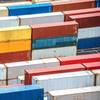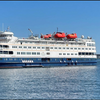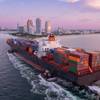Ro-ro operations at the Port of Gothenburg are looking bright, with sustained growth three years in succession. There has been an increase of 10 per cent over the past year alone, with the number of units currently standing at 593,000.
But there is still potential to raise the bar even further by switching a higher proportion of freight from Norway to Gothenburg from land to sea. It is hoped that closer collaboration between the ports in Hirtshals, Kristiansand, Larvik, Grenland, Risavika, Bergen and Zeebrugge will help reinforce intra-Nordic shipping, and at the same time reduce carbon emissions.
Intra-European ro-ro traffic to and from the Port of Gothenburg is looking healthy, and destinations such as Kiel, Frederikshavn (Stena Line), Immingham, Grenland, Ghent (DFDS) and Zeebrugge (CLdN, EML, SOL) are reporting good growth.
Working in collaboration with several North European ports, the Port of Gothenburg is hoping to link up more destinations as part of intermodal collaboration that will contribute to a more efficient, climate-smart logistics system.
The shipping company CLdN operates between Zeebrugge and Gothenburg. In between, there is the port of Hirtshals in Denmark, which is visited on a regular basis by vessels from Norwegian ports, including Kristiansand, Larvik, Grenland, Risavika and Bergen, along with the ports of Seydisfjordur in Iceland and Torshavn in the Faroe Islands.
With CLdN adding Hirtshals to the loop between Zeebrugge and Gothenburg, conditions have been created that will allow more freight to be transported by sea to Sweden.
According to Jacob Minnhagen, Senior Business Development Manager at the Gothenburg Port Authority, the opportunity to call at Hirtshals en route to Gothenburg is something of a logistically underutilised resource: “It could be an ideal alternative for a large proportion of the North European freight that is currently transported by road each day from, for example, Norway to Gothenburg and the rest of Sweden. Road transport leads to congestion and significant carbon emissions. This collaboration offers the potential to make logistical alternatives more efficient and environmentally friendly.”
The newly opened Arken combi terminal at the Port of Gothenburg, which has a higher capacity than the old combi terminal, and is located closer to the port, is one of the factors that makes intermodal solutions even more attractive than previously. From the Port of Gothenburg and the new combi terminal, the whole of Sweden can be reached on a daily basis using intermodal rail traffic.
Jacob Minnhagen explained: “With the new combi terminal located close the port, coupled with the scope for rapid transshipment, the incentive to opt for a sea route is even greater. We are currently at the very start of this collaborative venture between the Nordic ports, but we hope that the potential that can be generated will attract the attention of many more players in the future.”
Ro-ro stands for roll-on/roll-off and refers to trailers and other wheeled cargo transported using freight ferries that operate on regular services within Europe. Ro-ro is very much an intra-European phenomenon, with high-frequency departures. The Port of Gothenburg developed ro-ro traffic fully during the 1970s. Since then, Swedish import and export companies have been able to reach a large number of European ports via ro-ro services from Gothenburg.















